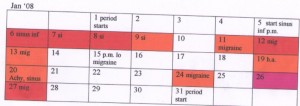 RSS FEED
RSS FEED
Archive for the ‘Tips & Techniques’ Category
Migraine, Chronic Illness and the Not So Happy Homemaker, or All in a Labor Day’s Work
September 1st, 2008
I do not claim to have ever been a great homemaker. I enjoy well organized space. I enjoy design, and
line, and tweaking the environment around me for comfort, beauty, and efficiency. So perhaps I am a perpetually frustrated homemaker, because these joys are rarely ever mine. I live in a state of clutter, disorganization, confusion and catch-up. Uh-oh, now I’ve told the truth. Will you ever listen to what I have to say again?
Wherever you start on the spectrum from neat-freak to pig-pen, Migraine and chronic illness will hamper your ability to get it all done. I remember a time before my Migraines and sinus infections became frequent, before chronic fatigue reared its ugly head, and, let’s face it, before I had children, when my home was tidy on a weekly basis, at least. When Danny and I first moved in together I wanted to get up on Saturday morning and get the housework over with, and then enjoy the rest of the weekend. He wanted to lounge around on Saturday morning and get to it later. Which generally meant we’d be cleaning at 5 pm, when we had plans to go out later, and we would do less than I wanted, and I would worry about it and not get to relax at all. But this is a blog about Migraine, right, not about relationships? I thought that issue was difficult at the time. What I deal  with now is of a different order of magnitude.
with now is of a different order of magnitude.
I have a generous, hard-working and willing husband who tries to maintain order in our home, with or without my help. He is also a fabulous cook and does most of the cooking. I have a nearly adult daughter who is a willing helper when she has the time, and a son who has come a long way with being helpful. I am also the one of the four of us who is not diagnosed with ADHD. This means I am the only one who can really multi-task. It means I’m the only one who notices a lot of the clutter. It means that I am the Captain of this house. So if the Captain is in sick bay, the ship may end up on the rocks.
I have had, this past 12 months, the worst year for Migraine and the year with the most sick days, since I began my Migraine and wellness diary 5 years ago. That means the house is in an advanced state of mess. It had never been tidy, but it’s worse than usual. Deborah at Weathering Migraine Storms posts about her craft projects and I feel jealous – I love crafting too, but it seems pointless to decorate when everything is a mess. The energy I’d like to spend on creativity, or on organizing, is so often taken up with the basics, dishes, kitchen counters, laundry.
But I have to stop and count my blessings. Unlike some Migraineurs, I can still work for a living. So if my energy and time is limited, and I spend it helping to keep a roof over my family’s head, I can’t fault myself for the state of things under that roof.
my energy and time is limited, and I spend it helping to keep a roof over my family’s head, I can’t fault myself for the state of things under that roof.
My advice to you, and me: cut yourself some slack. Do the best you can and take the time to enjoy life. Keep blocking out your time in the calendar to make the most of the time you have, working from your priorities. See More Time Management for Migraineurs: Managing the Time we Have for some more ideas on how to do that. As for me, today I’m post-drome and having some vertigo. I am doing my best to make my way through a back-log of dishes (the dishwasher is broken) and fold the laundry, with plenty of resting time in between. Happy Labor Day!
– Megan Oltman
Dirty dishes image courtesy of Easternblot – eva.
Tags: ADHD, chronic fatigue, chronic illness, clutter, crafts, housework, migraine, sinus infection
Posted in Managing, Musings, Tips & Techniques | Comments (2)
Exercise and Migraine Prevention: Take Two
July 10th, 2008
 I promised to get you some more evidence to answer the question: Does exercise aid in Migraine prevention? And in the interim, this news cropped up: The Journal Headache recently published a review of eight studies and four case reports of exercise as migraine therapy. Dr. Volker Busch of the University of Regensburg, Germany, reviewed the studies, and found that
I promised to get you some more evidence to answer the question: Does exercise aid in Migraine prevention? And in the interim, this news cropped up: The Journal Headache recently published a review of eight studies and four case reports of exercise as migraine therapy. Dr. Volker Busch of the University of Regensburg, Germany, reviewed the studies, and found that
“most studies did not find a significant reduction of headache attacks or duration due to regular exercise. Six of the studies demonstrated a reduction of pain intensity during the intervention.”
Read full coverage at My Migraine Connection. Please note, though, that the answer is not “No.” The answer Dr. Busch’s review provides is that: 1) in the studies reviewed, there was not a significant reduction in number or duration of migraines; and 2) there is not yet sufficient evidence to state with certainty whether or not exercise helps.
Does this mean we give up on exercise? No! I gave you my little piece of anecdotal evidence a few weeks ago in the post Exercise for Migraine Prevention. My update since that time? I have exercised 27 of the last 30 days. I have had 3 migraines in that time. Contrast that with an average of 6.5 migraines per month for the last 7 months, with sporadic exercise. It’s not scientific evidence of anything, mind you. All I can tell you is that exercise is making me feel good!
What does exercise do for us?
- Exercise releases endorphins, which are our body’s own pain-killers.
- Exercise relaxes our muscles – it reduces muscular tension.
- Exercise reduces our general fatigue and helps us sleep better.
- Exercise tones our blood vessels and increases blood flow.
- Exercise reduces anxiety levels and increases relaxation.
- And then there’s all that stuff about a healthy heart, a healthy weight, regulating our blood sugar, just the general things that keep us alive!
Read more on the benefits of exercise from migraine blogger James Cottrill at Relieve-Migraine-Headache.
It stands to reason, I believe, that exercise might reduce migraine frequency or severity. I can’t promise you, of course, that it will do that for you. Migraine is, among other things, an outcome of a sensitive, highly reactive nervous system. Whatever we can do that makes us stronger, healthier, more relaxed, more stress-hardy, ought to make our systems less reactive.
Most of us are also aware of the problem of exercise-generated migraines. The key is to take it slow and gentle. A couple of great articles on how to work in some exercise without setting off migraine are Teri Robert’s 10 Ways for Migraineurs to Sneak in Some Exercise, and Ellen Schnakenburg’s Moving and Exercising and Migraine. Also remember to drink lots of water and avoid hot sun if it’s a problem for you.
I don’t have medical studies to back me up here! But medicine is art as well as science, and I’ll tell you that all my doctors are telling me I need to get regular exercise! So don’t let “it’s not proven” mean “why bother?”
– Megan
Breezy, clear, sun getting lower – time for a walk!
What does that sailboat image have to do with it? That was my daughter’s first solo sail – she was getting some great exercise!
Tags: endorphins, exercise, migraine prevention, vascular health
Posted in Managing, Medicine, Tips & Techniques | Comments (7)
Migraine? Where do I Start?
June 20th, 2008
Do you have migraines? Severe, disabling head pain, sometimes accompanied by flashing lights and other visual disturbances, usually accompanied by nausea, light and sound sensitivity? If you do, you know how Migraine disease can impact your life.
- The pain can strike at any time. When it comes, it throbs and pounds on one or both sides of your skull.
- People around you may not understand. Most people have headaches,
but only 12% of us have Migraine disease. You may feel guilty and
question yourself – are you making too big a deal out of this? - Your migraines may seriously impact your ability to perform on your job.
You may risk job loss from frequent unpredictable absences or inability to perform at top productivity. - You may be tired of all the wasted hours spent in darkened rooms. You may despair at your inability to keep the basic routines in your life moving forward.
- Maybe you have not sought medical help. Maybe you thought you should be able to handle it on your own. Maybe you sought medical help but didn’t get it, because your doctor doesn’t understand migraine, or because you were turned away at the emergency room as a drug-seeker.
- You may be overwhelmed by all there is to manage, even with medical help – treatments, lifestyle changes, remembering all your meds and supplements at the right times, tracking your migraine triggers, recognizing patterns.
And while dealing with all of this, you struggle to remember that you are more than just your migraines.
You are not just a patient, or a chronically ill person. You are a unique human being with things to contribute, people who love you, talents and strengths.
If you fit these characteristics, the first thing I have to tell you is, there is hope. While there is no cure for Migraine disease, there are many proven strategies and treatments that can reduce your migraines
and enable you to take back your life.
Many of us struggle along for years, either with or without the diagnosis of “Migraine,” taking pain killers and coping with the migraines when they come, and then something happens. The pain gets worse, the attacks get more frequent, the symptoms change; suddenly what we always did to cope doesn’t work any more. We need answers. We pick up a book, talk to a doctor, search the internet. And we discover there is a lot of information, a lot of misinformation, and loads of people trying to sell us “cures!”
I wrote the free e-course “The Six Keys to Manage Your Migraines and Take Back your Life” to help people in that situation – people who are trying to get the information and support they need to cope with, manage, and recover from debilitating migraines. I wrote it to help people start down the path to managing their migraines and taking back their lives.
In the The Six Keys to Manage Your Migraines and Take Back your Life we discuss:
- What Migraine disease is: the more you know about Migraine, the more power you will have over it.
- How to get good medical support.
- How to recognize your triggers and your early warning system for Migraine.
- The value of a good Migraine calendar and diary.
- Cultivating support systems of people and routines to help you manage your life.
- Using relaxation to calm your nervous system and reduce your migraines.

I would love to have you use the course as a resource for yourself as you work on managing your migraine disease. If you’d like to register for The Six Keys to Manage Your Migraines and Take Back your Life just fill out the box at the upper left corner of this page. The e-course will be delivered to you by email every two days over approximately two weeks. As you receive each lesson, take some time to think about how it applies in your life, and follow the action steps included in each lesson. I will be available by email for help and feedback as you work your way through the course.
For over ten years I have worked to help my clients live healthier, more productive lives. I am certified as a life and business coach; I am also a migraineur. I have succeeded in reducing my migraine frequency and severity by over 50% through a combination of medication and lifestyle approaches. I have run my own business for fifteen years while managing Migraine and several other chronic illnesses. I am committed to helping people live healthy and productive lives, creating a thriving world we all want
to live in. For those of us with Migraine disease, that means more than relief from pain – it also means living the best lives we can, using our talents, and knowing our strengths.
This is the game I love to play. You can play it with me!
– Megan Oltman
Please come out to play!
Cave exit photo courtesy of David Wilmot; Smoo cave waterfall photo courtesy of Subflux
Tags: Migraine disease, Migraine treatment
Posted in Managing, Tips & Techniques | Comments (3)
Sit up and Read Blogs! Blog Carnival Time!
June 10th, 2008
Hello dear, readers, I’ve missed you. Since I was scraped off the bathroom floor last week I have been sick in bed with the worst case of bronchitis I’ve seen in many a long year. More about that later. (Is that a threat or a promise?) Today I’m sitting up to read blog carnivals! There are tons of good reading!
Posted yesterday, June 9th, there’s:
 The June Migraine and Headache Blog Carnival. At The Migraine Girl,
The June Migraine and Headache Blog Carnival. At The Migraine Girl,
where host Janet Geddis treats us to a range of great posts on “How to have a Happy, Healthy Vacation” despite Migraine or headache disease. Some are practical tips with checklists on being prepared; some are personal experiences of vacations that worked, and vacations that didn’t. There are also a number of posts on controlling stress, triggers, and emphasizing relaxation, which will serve us well whether we’re on vacation or not. Janet has done a great job of cataloging and describing the posts, and I for one am looking forward to some great reading.
And posted today, June 10th, there’s:
The June Living with Pain Blog Carnival. Hosted by Marijke Durning at Help My Hurt, the scope of the articles is wide, from practical and alternative treatment strategies, to communicating with doctors, discussing the world of health web sites, to meditation and spiritual stories. Something for everyone who’s living with pain.
Wishing you pain free days and nights,
– Megan
Carnival Lights image courtesy of Gilberto Santa Rosa
Tags: headaches, living with pain, migraine, vacation, Weblogs
Posted in Managing, Tips & Techniques, Weblogs | Comments (0)
More Time Management for Migraineurs: Managing the Time we Have
May 28th, 2008
Do try this at home. And at work. I wrote a post a while back on How do you Manage Life with Migraine?, about managing our time when migraines interrupt us all the time. Those of you receiving the newsletter got an expanded version of that post in the article “Time Management for Migraineurs (or, how can you get everything done when you can’t get anything done?).”
The gist of those pieces was that 1) whatever is on your list, you must learn to accept that you will never get it all done; 2) you need to choose what is most important to you and put those things in your schedule first; and 3) if you keep detailed lists of what you are working on, next steps, what you need to handle if you get sick, and what you need to care for yourself, you will best be able to pick up where you left off. I recommend Time Management from the Inside Out by Julie Morgenstern, as the best system I have come across for managing your time to make sure that you spend it on what is most important to you. And as I mentioned last week, Teri Robert has taken this idea of list-making and planning for Migraines much further in the helpful article MAPP Your Migraine!
All of that said, it occurred to me last week that I had left an important piece out. This may look like a blinding flash of the obvious, but it hit me that a key piece to making this all work is that we can only manage the time we have. Please don’t say “Duh” yet. Take a moment to let this sink in.
I read an intriguing post on How to Cope with Pain earlier this month, called Time Management and Pain. What intrigued me was that rather than laying out any nitty-gritty on scheduling and managing time, the article focused on “pacing ourselves and keeping stress to a minimum.” In other words, to manage time, we need to manage our own, often over-achieving and denial-ridden, selves!
We can only manage the time we have. I looked back over my Migraine and Wellness calendars for the last 5 years. I’m happy to say that my time spent incapacitated by Migraine and my other illnesses decreased over those 5 years from 27% of the time to 22% of the time. I have focused on increasing that
trend, with mixed results. I go up and down; there are months where I’m down more than I’m up. What I have not always remembered is that, however you slice it, I will be down for the count about 25% of the time.
When I look at a beautiful, clear, blank work week in my calendar, I can’t say, “Oh, goody, 50-60 working hours to schedule into!” Into that week I need to put all of the things that allow me to maintain my health, to pace myself and keep stress to a minimum. For me that includes exercise every day that I am capable of doing it. It includes 20 minutes of meditation or relaxation practice every day. It includes eating lunch away from my desk – taking breaks that are real breaks. And once I have put all those things in, that help me keep stress down and stay well, I still only have about 75% of the remaining time available for my work!
This means if I set deadlines for myself, I set them taking that
percentage of time into consideration. It means when I block out my
week, I leave blocks of “not working” time. It means when I come right
down to it, I have about 27 hours of productive working time that I can
count on in a week. Now I’m not a workplace productivity expert, but
I have worked in a lot of places, for others and for myself, and I
don’t think many people are really productive much more of their time
than that.
I have felt such freedom since I have been scheduling this way! My
productive time tends to be really productive; I stay focused on what
I’ve set out to accomplish in that time, knowing that I have a
reasonable
break coming. I can use my “not-working” time for those
water-cooler type conversations we tend to have at work, or for actual
work if I choose. Of course I can’t control that I will schedule my
migraines into the hours I have allotted, but there’s room in the
schedule to rearrange things when I do get sick. And when I am sick I
don’t worry about what’s not getting done. Without the added stress of
that worry, I can recover faster.
Since I am self-employed, I know I have more freedom around these issues than some of you who hold down “regular” jobs. But you can find ways to use these ideas. It may be about how you approach your time away from work. It may be about how you pace yourself at work. Please share your thoughts on managing the time you actually have!
– Megan
Tags: meditation, migraine, productivity, relaxation, stress management, time management
Posted in Managing, Tips & Techniques | Comments (2)
Alternatives to Compact Fluorescents – for Migraineurs and the Rest of You!
May 19th, 2008
I posted last week about compact fluorescents and their impact on some migraineurs, epileptics, people with lupus and possibly other conditions. While we work on getting Congress to amend the law which would phase out sales of incandescent bulbs by 2012, here are some thoughts about energy saving alternatives you can use at home. Thanks to my friend Dave Cohen, of DEC Architect, an architect specializing in green design, for these suggestions.
1. Turn your lights down low – installing and using dimmers with your incandescent bulbs can save a surprising amount of energy. Using a light bulb at 75% of full wattage can actually cut electricity use by 50%! If you’re like me, you prefer the lights on the low side to ward off migraines anyway.
2. Pull your window curtain – use natural light as much as possible! If you are doing new construction, build to take advantage of natural light with the orientation of your windows and use of reflective surfaces to catch and multiply that natural light. Even with existing windows, let as much light in as possible, and do what you can to reflect it back around the room.
build to take advantage of natural light with the orientation of your windows and use of reflective surfaces to catch and multiply that natural light. Even with existing windows, let as much light in as possible, and do what you can to reflect it back around the room.
3. Shine the light up – (sorry I ran out of Bob Marley references there) torchiere style halogen lights can illuminate a room with less wattage than an incandescent. Halogens are one of the lower energy use lighting sources that are under further development. Shining the light up on the ceiling spreads it; it is also easier on migraine brains than light shining down into our eyes.
4. Light up with LEDs – LEDs are another alternative technology which are being further developed. You know, those bright little green, blue, etc, lights? I know some migraineurs have trouble with LEDs, which can be very bright. An LED light which can be dimmed would be a great alternative. (They could also save a lot of energy by removing the LED lights on my computer power cord, so my darn room could actually be dark at night.)
Any more energy saving, migraine friendly lighting tips? Please share them in the comments. Thanks to Dave Hobbs and his comment on the last post, for inspiring this post!
– Megan
This little light of mine, I’m gonna let it shine (but not too brightly…)
Tags: Bob Marley, compact fluorescent, halogen, LED, migraine
Posted in Managing, Music, Tips & Techniques | Comments (3)
How do you manage life with Migraine?
March 1st, 2008
Fine, thank you, how do you? Oh, sorry, wrong tape…
How do you manage life with migraines? With many interruptions. With difficulty. Intermittently. With ridiculous persistence and hope. Occasionally, with grace.
ridiculous persistence and hope. Occasionally, with grace.
But, how? You want the nitty-gritty? It’s a lot like managing anything else. I’ve been coaching people for years in how to manage a small business, how to manage themselves to grow their business and have the life they want. You manage by having systems. By:
1) taking the great long overwhelming list of all the everything that goes into your enterprise and sorting it into categories,
2) listing out the individual tasks in each category,
3) creating the ongoing schedule of the tasks that need to be accomplished at regular intervals,
4) listing the one time, current tasks,
5) prioritizing those tasks and scheduling them,
6) listing any background preparation or materials needed before doing the tasks,
7) listing likely follow-up that will have to be done after the tasks, and
8) creating checklists.
No matter how difficult or overwhelming something seems, it can be managed if broken down into tasks, and if each of those tasks is further analyzed for preparation and follow-up tasks. This works for a business enterprise; it works just as well for enterprise YOU – the enterprise of your life.
But my head hurts! Yup. Mine too. That’s why when I take to my bed with migraine, my computer or at  least a lined pad of paper goes with me. Unless I am too sick to have any light on, or think at all (and that certainly does happen), I lie down thinking, “what do I have to handle, make sure of, not forget, or reschedule?” And as soon as I’ve answered the question, I can give myself over to whatever I need to do to get better. It’s like calling in sick for your life. If I am going to help my (actual) headache get better, I have to be able to let go of as many as possible of the figurative “headaches” called running a life.
least a lined pad of paper goes with me. Unless I am too sick to have any light on, or think at all (and that certainly does happen), I lie down thinking, “what do I have to handle, make sure of, not forget, or reschedule?” And as soon as I’ve answered the question, I can give myself over to whatever I need to do to get better. It’s like calling in sick for your life. If I am going to help my (actual) headache get better, I have to be able to let go of as many as possible of the figurative “headaches” called running a life.
I need to have all the medications I need close to hand. I need to make sure people will be fed, whether or not I’m doing the cooking (maybe I’m just asking someone else to handle it). I need to cancel appointments, or have someone else do it for me. I need to remember to call the doctor, or whoever else I really should be calling. If I can’t stay in bed, if buying the groceries or getting the kids somewhere, or going to work simply cannot be avoided, I need a checklist for that too. That’s the absolute minimum checklist. What’s the absolute minimum list of tasks I cannot avoid doing?
When I’m having a migraine, my brain doesn’t work too well. If the pain is bad enough, there’s nothing to do but lie still and try to sleep. If it’s not that bad, I still live in an extended state of “Ummmm…” If all I need to do is take meds, I still need a list of them or I will forget.
So I try to invent all my checklists ahead of time. Healthy day checklists – including what I need to do daily to stay healthy. Sick day checklists. Preparation lists and schedules, to refill prescriptions, to keep what I need on hand.
what I need on hand.
How do you take something as unpredictable and disruptive as a life with migraine disease and be systematic about it? With many interruptions. With difficulty. Intermittently. With ridiculous persistence and hope. Occasionally, with grace.
– Megan Oltman
Today I’ve got a cold, or sinus infection, or migraine brewing, or some combination thereof. Anybody’s guess. Taking it slow, checking my lists. Such is (my) life.
Tags: managing life with migraine, time management
Posted in Managing, Tips & Techniques | Comments (5)
Calming down the migraine brain
February 20th, 2008
Several people have asked me lately about relaxation techniques. If stress is our enemy, we need to relax, yes? But if we strive and worry about whether we’re relaxing, we tense up. Raise your hand if this applies to you. My hand is up. Luckily there are some very simple techniques you can use to begin to practice relaxation.
relax, yes? But if we strive and worry about whether we’re relaxing, we tense up. Raise your hand if this applies to you. My hand is up. Luckily there are some very simple techniques you can use to begin to practice relaxation.
Relaxing is not the same as doing fun things – fun things may or may not be relaxing. When I had my first job out of college I used to go to the video parlor on my lunch hour and play PacMan (yes, I am that old). I would return to work with my wrists and hands asleep, so stressed out I could
barely cope. I learned eventually that video games are not relaxing for me!
Our nervous systems have two components – the sympathetic and the parasympathetic. The sympathetic
 nervous system controls stress – this is where our flight or fight response comes from. The parasympathetic nervous system controls relaxation, which is often neglected in a busy twenty-first century life. We can build the tone of our parasympathetic nervous system in many ways, including through deep breathing, meditation, moderate exercise, yoga and movement, stretching, reading a good book, having an enjoyable conversation, playing with children or animals, being out in nature, loving touch or sexual contact. If we take some time to strengthen our relaxation “muscles” daily, we improve our ability to handle stress. According to Dr. Ian Livingstone, studies showed a 40% reduction in migraines in those practicing regular relaxation.
nervous system controls stress – this is where our flight or fight response comes from. The parasympathetic nervous system controls relaxation, which is often neglected in a busy twenty-first century life. We can build the tone of our parasympathetic nervous system in many ways, including through deep breathing, meditation, moderate exercise, yoga and movement, stretching, reading a good book, having an enjoyable conversation, playing with children or animals, being out in nature, loving touch or sexual contact. If we take some time to strengthen our relaxation “muscles” daily, we improve our ability to handle stress. According to Dr. Ian Livingstone, studies showed a 40% reduction in migraines in those practicing regular relaxation.
So here are a few ways to get started:
- Sit comfortably with your back supported, legs uncrossed, hands on your knees. Close your eyes. Breathe in deeply through your nose, for a slow count of three. As you inhale, allow your abdomen to inflate like a balloon. Then breathe out through your mouth for a count of five, gently pulling in your abdominal muscles as you exhale. Gently concentrate on your breathing. If you find yourself thinking of other things, don’t get upset with yourself. Gently remind yourself to focus on your breathing. Try doing this for five minutes at first. Each day you can increase the time.
- Lie on your back, legs uncrossed, arms resting comfortably at your sides. Bring your awareness to your feet. Notice how they feel, any discomfort. As you breathe in, imagine silver light being pulled with your breath into the soles of your feet. If there is any pain or discomfort in your feet, imagine that you are exhaling it out as you breathe. Next notice your ankles. Breathe in and pull the silver light up into your ankles. Breathe out any pain or discomfort. Continue to gently pull the silver light up through your body, being aware of each part of the body in turn and blowing pain or discomfort out with your breath. If pain still remains, don’t fight it or worry about it. Just keep breathing the light into your body and exhaling out the pain. Continue until your body is glowing from head to toe. You may want to do this in bed to help you fall asleep.
- Take a walk and practice keeping your awareness in your body as you walk – the way your muscles feel when they move, the way your feet hit the ground. Be aware of the
 rhythm of your breath and
rhythm of your breath and
the rhythm of your walking. Look at any trees or plants, any living things or natural features you pass – fully observe them as you pass. If you find your mind getting busy, working or worrying at anything, gently return your attention to your body and to the trees, ground, plants, rocks or sky. If you are walking in the city be aware of the sky, the wind, any elements of the natural world.
Give these techniques a try and let me know what you think!
– Megan Oltman
Not trying to be stressless, but to stress less!
Tags: Migraine management, relaxation practice, relaxation techniques
Posted in Managing, Tips & Techniques | Comments (2)
“Breaking the Headache Cycle”
February 18th, 2008
Breaking the Headache Cycle by Ian Livingstone, M.D. and Donna Novak, R.N.
When my migraine pattern suddenly shifted from once month or less to three to four times per week, I  went to see Dr. Livingstone. When I first saw him in August of 2004, it was six months after I had two episodes of anaphylactic shock, caused by ibuprofen. I was a little gun-shy of trying new medications. I did agree to try Imitrex – I needed to be able to abort my attacks. But instead of preventive medications, Dr. Livingstone suggested that I get into a regular relaxation routine – using deep breathing, meditation and
went to see Dr. Livingstone. When I first saw him in August of 2004, it was six months after I had two episodes of anaphylactic shock, caused by ibuprofen. I was a little gun-shy of trying new medications. I did agree to try Imitrex – I needed to be able to abort my attacks. But instead of preventive medications, Dr. Livingstone suggested that I get into a regular relaxation routine – using deep breathing, meditation and
guided imagery to strengthen my nervous system’s relaxation response.
I first read the book at that time: Breaking the Headache Cycle: A Proven Program for Treating and Preventing Recurring Headaches. I took on practicing meditation daily, and after about six months I found my migraines reduced to 2 or 3 per month. The methods outlined in the book were very effective for me, in combination with the migraine abortive, to reduce my migraines to a manageable level.
The authors say migraineurs’ nervous systems are “very reactive to any change, even good change. This
sensitivity is the hallmark of the migraine condition. Unless it is understood and recognized, the migraine disorder cannot be adequately treated.”
If our nervous systems are over-responsive, it makes sense that relaxation and meditation will calm down the responsiveness of the nervous system. Dr. Livingstone cites studies showing that preventive medications reduce migraine about 40% on average (the book was published in 2003 – there may be more up to date statistics on this); and other studies showing that a regular relaxation practice reduces migraines 40% on average. Is it a safe bet to say if doing both, we might reduce migraine 80%? That’s a number I could be very happy with!
down the responsiveness of the nervous system. Dr. Livingstone cites studies showing that preventive medications reduce migraine about 40% on average (the book was published in 2003 – there may be more up to date statistics on this); and other studies showing that a regular relaxation practice reduces migraines 40% on average. Is it a safe bet to say if doing both, we might reduce migraine 80%? That’s a number I could be very happy with!
Many times I pause and do deep breathing when I first feel pain in my head, or even just when I feel my tension mount. This often down-shifts me from a budding migraine back to a state of no head pain. I have come to be able to notice when I am getting too excited or too engaged – it’s not just negative 
stress that can trigger me! Not surprisingly, when I got out of the habit of practicing regular relaxation, my migraines increased again. As tricky as
it is to remember to take a variety of medications, in the right amounts, at
the right times, I think it is even more challenging to establish and keep a
routine of putting the busy concerns of life aside and take time out to look
inward, breathe deep, become aware of the body, calm oneself, and relax.
I came to these methods already convinced – I was not a stranger to yoga, meditation and relaxation. I had practiced yoga in many periods in my life, starting in my teens, and meditation and guided imagery from my early twenties. Later, as a life and business coach, I have used meditation and guided imagery with my clients to help them get clear about issues that were stopping them, and to visualize what they wanted in their lives. So I wasn’t surprised that this practice would aid with migraine disease as well. The challenge is
keeping it in my life as all the demands of life crowd in. The reward is getting to know my own system
really well, and gaining at least a little bit of control over it.
By the way, I think preventive medication is a great thing, and many migraineurs find a lot of success with it. I may be headed down that path myself, as my migraine pattern has changed and my treatment will need to change too. But I’ll always keep relaxation as part of my routine. It makes me feel good!
– Megan Oltman
Nothing to gain from pain!
Tags: Breaking the Headache Cycle, Ian Livingstone MD, Migraine attack, Migraine preventive medication, reactive nervous system, relaxation practice
Posted in Books, Managing, Medicine, Tips & Techniques | Comments (2)
Migraine Management – My Other (other, other, other) Full Time Job
February 6th, 2008
A week or two ago I posted about living healthy – a few comments there got me thinking (again) about just how challenging this is. Getting it all right really does feel like a full-time job. It’s time-consuming-picky-detail-oriented, and doesn’t fit with the way most “normal” people live their lives. (By the way, I’m still interested in finding one of those “normal” people – if you spot one, let me know!)
This morning I am off to the doctor for a general health consult. I have a lot of questions for him and wanted to go in when I wasn’t feeling awful, for once, and would be more able to pay attention. I’m feeling okay today – not great but okay. Okay is good, I can live with it. So I have been preparing for the appointment: printing out the last 9 months of my “wellness calendar.” Here’s what January looked like: I color in days when I feel great as pink (when “I’m in the pink”) – I only had one of those. Days when I am sick but functioning are orange; when I am functioning about half-way are red; totally out for the count are brown. I had a very red and orange January, luckily no brown days.
feeling okay today – not great but okay. Okay is good, I can live with it. So I have been preparing for the appointment: printing out the last 9 months of my “wellness calendar.” Here’s what January looked like: I color in days when I feel great as pink (when “I’m in the pink”) – I only had one of those. Days when I am sick but functioning are orange; when I am functioning about half-way are red; totally out for the count are brown. I had a very red and orange January, luckily no brown days.
 So then I printed out the narrative part for the last month, that shows how much I slept, what changes I made to my diet, details of my migraines and sinus infections. I printed my checklists for caring for myself when I have a sinus infection or migraine, so the doctor can review them. I wrote out my questions. Here’s what my desk looks like right now. The yellow book in the pile is Breaking the Headache Cycle by Ian Livingstone, M.D. I don’t think messy desks are identified in there as a migraine trigger, but it still seems ironic!
So then I printed out the narrative part for the last month, that shows how much I slept, what changes I made to my diet, details of my migraines and sinus infections. I printed my checklists for caring for myself when I have a sinus infection or migraine, so the doctor can review them. I wrote out my questions. Here’s what my desk looks like right now. The yellow book in the pile is Breaking the Headache Cycle by Ian Livingstone, M.D. I don’t think messy desks are identified in there as a migraine trigger, but it still seems ironic!
I got up at 6:10 to get the kids’ breakfast and get the younger one off on the bus (the older gets herself off on the bus – let’s be clear about that). I dealt with dishes and then went back to sleep for 45 minutes since I’d had only 6 1/2 hours of sleep which is a pretty reliable migraine trigger for me. But when I got up again there was only time to prepare for the doctor and write to you here. So I have not done my meditation/relaxation practice for the day or gotten my exercise, both of which are important to keep myself healthy and resistant to migraine triggers. I’m going to have to fit them in this afternoon, when I will also be worrying about getting all my work done for the day. Stress alert!
I so want to be perfect at my treatment plan and know perfectly (!) well I’ve never been perfect at much of anything. It reminds me of one of those annoying parabolas (or was it a hyperbola?) from Trigonometry – approaching zero but never reaching it. The ridiculous emotional see-saw of trying to do it all but without stressing about it. Time for the Serenity Prayer again. Time for the rainbow picture again – the perfect rainbow over the field outside my window – reminding me of the return of hope. What would we do without it?
reminds me of one of those annoying parabolas (or was it a hyperbola?) from Trigonometry – approaching zero but never reaching it. The ridiculous emotional see-saw of trying to do it all but without stressing about it. Time for the Serenity Prayer again. Time for the rainbow picture again – the perfect rainbow over the field outside my window – reminding me of the return of hope. What would we do without it?
– Megan Oltman
Hurrying up without Being in a Hurry!
Tags: healthy living, Ian Livingstone MD, Migraine management, migraine treatment plan, relaxation, wellness calendar
Posted in Managing, Tips & Techniques | Comments (2)
That disclaimer thing...
Remember: nothing we do here is medical advice or treatment or is a substitute for medical advice or treatment. Get competent medical advice to learn more about your migraines, possible treatments and risks.
What's New on Migraine Support Group Coaching |
Recent Comments
- on Calling all Redheaded Migraineurs
- on No, You’re not Crazy, You just Have Migraines
- on No, You’re not Crazy, You just Have Migraines